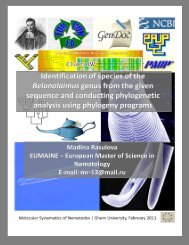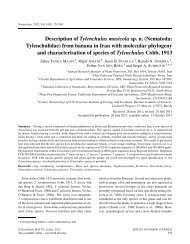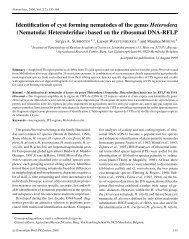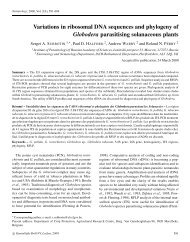You also want an ePaper? Increase the reach of your titles
YUMPU automatically turns print PDFs into web optimized ePapers that Google loves.
TreeView manual<br />
Save as<br />
11/10/04 3:10 PM<br />
Enables you to saves the tree(s) to a file with a different name using a number of different formats. The default is a<br />
NEXUS file with TAXA and TREES blocks, however you can also save just the TREES block, or write a<br />
PHYLIP or Hennig86 style tree file.<br />
The dialog box (Macintosh version shown above) also gives you control over whether the trees have branch length<br />
information and internal labels (if available), and if you’ve defined an outgroup you can choose to root the trees<br />
before saving them.<br />
Save as graphic<br />
Saves a picture of the current tree as a PICT file (Macintosh) or Windows Metafile (Windows). These formats can<br />
be read by most graphics programs and word processors. The picture is scaled to fit onto the current page setting<br />
(these can be changed using Print setup).<br />
Import submenu<br />
The Import submenu lists commands that access trees in formats other than the standard ones the Open command<br />
can read.<br />
List of taxon names<br />
This command reads in a list of taxon names, one per line, and constructs a star tree for them. You can then use<br />
<strong>TREEVIEW</strong>'s tree editor to edit the tree. This command provides a quick way of creating trees from lists of taxa.<br />
The file containing the taxa must be an ASCII text file with one taxon name per line, e.g.:<br />
taxon one<br />
taxon two<br />
http://taxonomy.zoology.gla.ac.uk/rod/treeview/treeview_manual.html#_Toc356614792<br />
Page 6 of 16
















